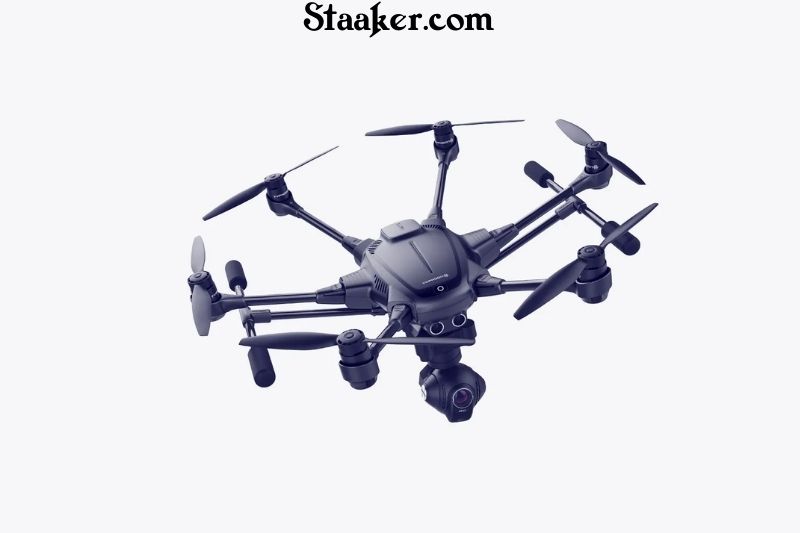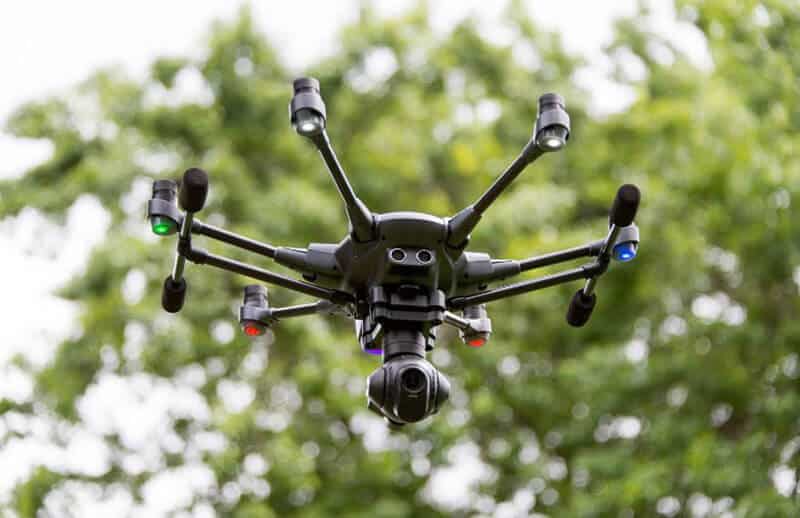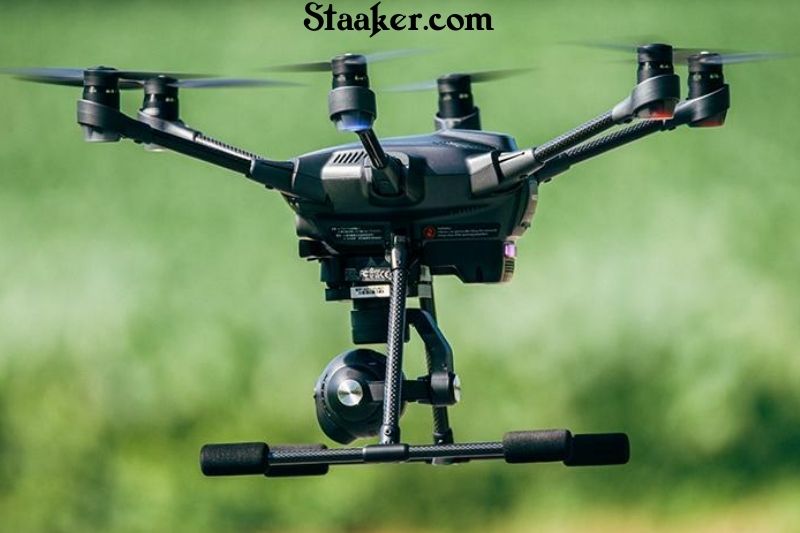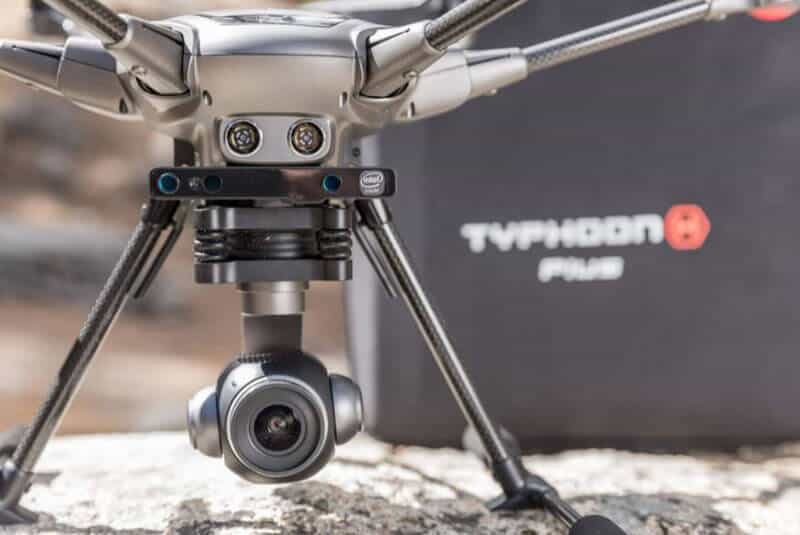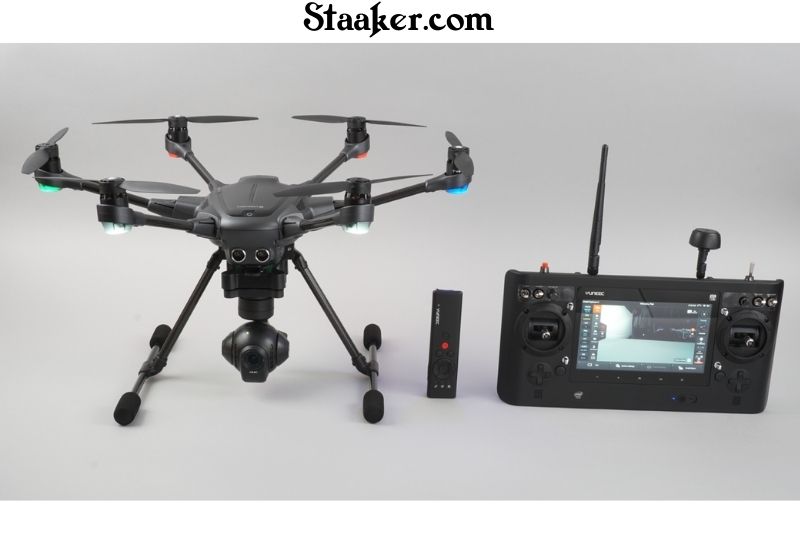Yuneec has been creating powerful, advanced drones for years to challenge DJI as the market leader in high-performance drones for aerial photography. With the release of Typhoon H, Yuneec seems to be finally making progress.
The Typhoon H will include all features of DJI Phantom 4 (P4) and some extras. Let’s take a look at our Yuneec Typhoon H Drone Review below to see what makes this drone unique.
Yuneec Typhoon H Review
- READY OUT OF THE BOX - Comes...
- SAFE TO FLY WITH BUILT-IN...
Pros & Cons
Pros:
- Reliable, stable flight
- 360-degree camera
- Touchscreen controller
- Autonomous flight modes that are intuitive and intuitive
- You get a lot for your buck.
Cons:
- The hinges supporting the rotor feel fragile.
- Battery recharge time is long.
Specs
| Dimensions: | 20.5x18x12.2 in (520x457x310mm) |
| Battery: | 4S 14.8V LiPo Battery (POWER 4) |
| Battery Capacity/Voltage: | 5400mAh 4S/14.8V(79.9Wh) |
| Charger: | SC4000-4 |
| Rotors: | 6 (2 blades per rotor) replaceable, 9.25-inch diameter |
| Flight Time: | Up to 25 min |
| Maximum Flying Height: | 122m(400ft) agl (Restricted by FAA ) |
| Transmitter: | ST16 Personal Station Ground |
| Airframe Weight (WITH BATTERY): | 59.8oz (1695g) |
Design
Typhoon H looks like a small, lightweight flying insect. Typhoon H uses six engines to fly. This is two more than the quadcopter. The six engines are located on the 9-inch carbon fiber arms that can be folded up to store the hexacopter. The arms can be folded up and locked in place when you are ready to fly.
The hexacopter’s flying height is 28.5 inches from the blade tip-to-blade tip and 13 inches from the landing gear to the blade top.
The hexacopter folds down to 11x11x11 inches for storage. Due to its carbon fiber construction, the hexacopter weighs in at 4.3 pounds. This includes the large 5400 mAh lithium battery. This drone is about one pound heavier than the DJI Phantom 4.
The controller weighs in at 2.6 pounds. It is very light for its size. The entire package comes in a sturdy foam box, which can be combined with a backpack of the appropriate size to make a portable drone kit.
The Typhoon H’s lithium battery fits into the drone’s center body, which houses all electronics. Typhoon H has a collision-avoidance system. This uses an ultrasonic rangefinder that detects objects ahead of it and stops them. Yuneec offers a model with an Intel RealSense camera system that maps and avoids obstacles. However, our test model didn’t include this. The Typhoon H Pro model costs $600 more.
Carbon fiber is used to make the landing gear. However, it has an unusual feature: once the drone has taken flight, the landing gear folds up against the body with a flick of a switch. The Typhoon H is a bit more aerodynamic, and the camera underneath the drone body has a 360-degree view.
Unlike other drones, the camera can rotate completely around the drone’s legs. Pans are now much easier because you don’t have to rotate the whole drone. Instead, the camera can be rotated for slow and subtler shots.
Rubber joints stop vibrations from the drone’s rotors hitting the camera. You can tilt the gimbal up to 10 degrees or down to see directly below. The gimbal rotates 360 degrees. The camera is spherical in shape and measures 3.5 inches in width. While most drone cameras look similar to GoPros, the CS3 camera looks a lot more like an EVA pod from 2001: A Space Odyssey.
However, hopefully with fewer murderous tendencies. The camera’s back houses the microSD card that stores the video. Video files can be saved as MP4 files. The included microSD card (16GB) can store approximately 45 minutes of video at the highest resolution.
Click here to see our comparison between Phantom 4 Vs Typhoon H.
Controller
The ST16 controller measures 13 inches in length and 7 inches in width. It is quite lightweight at 2.6 lbs and has a neck strap to hold it. The device runs a customized version of Android OS on an Intel processor. It is quite powerful. You don’t even need a tablet or smartphone to fly the TyphoonH: everything can be done directly from the controller.
Despite being large, it fits comfortably in your hand with two grips on either side. There are many buttons and dials on the controller. I counted five buttons, five switches, and three dials. This does not include the control sticks or directional buttons.
It is large enough to cause panic in a beginner, but the common controls (such as starting motors, stopping them, raising or lowering the landing gear, and starting video) are all within reach. The numerous dials also allow for smooth tilts and pans.
The settings and preview video are displayed on the LCD screen at the center of the controller. You can hide all this information by tapping on the screen. The screen will switch to a preview mode that only displays video previews.
Typhoon H’s video preview has 720P high resolution – this is unusual as most drones only send a preview at standard or lower resolution to their controllers or connected devices. This allows you to get a better idea of the final video, making it easier for you to spot potential problems during shooting.
Two antennas are located on top of the controller. One is for the radio control signal and the other for the video preview. Both antennas use signals in the 5Ghz frequency band, which Yuneec claims can be used over a distance of up to a mile. Although I didn’t get as far as the drones, I maintained control and received a preview video from about a hundred meters away. This is a significant distance.
Flying
Typhoon H drones are fun to fly. They respond quickly to your commands and offer plenty of speed. The drone can travel a little more than 40 miles an hour, according to Yuneec. Although it isn’t a racing drone, it can move at high speed.
It hovers quieter than other drones and produces less noise. Although it is not a stealth drone, the noise enough to be heard by local wildlife is loud enough to make them aware of its existence.
It is easy to perform slow turns and gentle climbs, which makes for a beautiful video. Separate controls at the back and front of the controller tilt and pan the camera. You can tilt without having to move your hands from the control sticks. However, you must release the control stick to the pan.
Typhoon H is a little more difficult to fly than other drones. Most drones can be unpacked and flown, but the Typhoon H will require you to unfold the arms and ensure they are properly locked before attaching the six rotor blades. Although it’s not difficult, it can make getting ready take longer. The motors are started by the big red button located on the left shoulder. A touch of the left stick will lift the motors off.
The Typhoon H hovers in the air and awaits your commands. It does require strong GPS signals. If the satellites are not working or the drone doesn’t have a strong location fix, the drone will bounce around and shift as the GPS fix updates. The drone and controller both received strong GPS fixes in under 30 seconds if there was a clear sky.
Typhoon H has an interesting feature: The drone can fly with a broken rotor. Yuneec says that if one rotor is damaged, it will be noticed and adjusted to compensate.
The preview of the Typhoon H video was slightly delayed by the compression, sending, and decompression process. This means that the preview is about half a second behind the real world. It’s not an issue most of the time, but it could be if you are close to something or flying from the preview. While most drones will have some delay, Typhoon H has a longer delay and requires careful flying.
Typhoon H has an ultrasonic rangefinder at the front that acts as a collision avoidance device. The drone will stop if it detects any objects in front of it when the option is enabled. It detected small objects, such as branches, but only when they were directly in front. It will not detect objects that are slightly behind or along with the drone.
Typhoon H has an interesting feature: The drone can fly with a damaged rotor. Yuneec claims that if one rotor is broken, it will alert and adjust to compensate. Although this is a great trick, it was not very useful. We found that collisions and crashes would often cause more damage to the rotors that were close together.
One instance was when we cut a branch, and the hexacopter spun immediately. This brought two other rotors in contact with the branch and caused them to break, sending the drone plummeting to the ground.
Typhoon H’s carbon fiber body proved very sturdy and resisted the 10-foot fall with no damage. A second crash was more problematic. The landing gear and gimbal mount were both broken by a similar fall.
Autonomous Flying
There are many autonomous flying modes available, and Typhoon H does most of it: Orbit Me. Orbit Me, Point of Interest, Journey, Curve Cable Cam, Follow Me, and Return Home.
Orbit Me mode will allow Typhoon H to orbit around the controller. The camera will be pointed at the operator as it moves around Typhoon H. You can adjust the distance and height of your orbit on the controller. The operator also controls the orbit’s speed.
The Point of Interest mode works similarly to the orbit mode but will orbit around a specific location defined by GPS coordinates displayed on the controller screen. The pilot can set the orbit’s radius, height, and speed.
The autonomous modes can be used and controlled easily.
The drone can fly to 150 feet from your current location and then return to 15 feet, with the camera pointed towards the operator. This mode is called Journey. This preset is great for those who are at the edge of scenic spots or cliffs. Curve Cable Cam will route the camera between several waypoints and orient it as you request. The curve is a result of the way that drone software calculates the route. This creates a smooth and curved path for the drone to follow.
The name “Follow Me” refers to the ability to follow the controller at a specific distance while keeping the camera pointed at it. The large controller can be cumbersome to transport on a bicycle, so Yuneec offers a smaller controller, the Wizard. It costs $140 and does not have a screen. This TV remote-sized controller can be carried in the Follow Me mode. It is smaller than the larger controller.
You can use it to control the Take-off, Landing, Height, and Start of the Follow Me Mode. You can also use it with the main ST16 controller (Yuneec refers to this team mode). The Wizard controls the drone’s flight, and the main controller controls its camera. Unfortunately, this was not available for testing, but it is an interesting idea for action sports users and can be bought online or at retailers.
These modes are simple to use and manage: tap the task button on your screen, choose the mode from the menu, and then follow the prompts. For novices, the prompts are simple and can be skipped if you have mastered how to use the modes. These modes were effective, but we found some limitations.
When I tried the Follow Me mode while holding the controller, it was slow. The Follow Me mode worked well when I was walking in a straight line. However, turning the direction caused it to lose its bearings. The drone’s tracking algorithm is likely to be compatible with a car or bike, which tends to keep moving in a straight line.
After you’re done flying, flip the flight mode switch back to H (for home). Typhoon H will automatically fly to approximately 30 feet above your home and land gently.
The Typhoon H performed in generally similar ways to the Phantom 4 or the 3DR Solo in these modes. Although each drone has a different approach, they all offer similar modes that allow you to fly autonomously and create photos. Although the Typhoon H is slightly more advanced due to its 360-degree camera rotations, all these drones can still create great shots once they are mastered.
Check out Best Autonomous Drone 2022, Click here.
Camera, Accessories, and Upgradability
The Typhoon H’s camera, dubbed the CG03+, is a modified version of the CGO3 you’ll find on their Typhoon Q5004K. The camera can record video at 30 frames per second in 4K and 1080p at 60 frames/second in 1080p – but it has a larger sensor, a faster processor, and a wider field of vision (115 degrees) than the predecessor.
The camera also captures 12 megapixel still photos and has a distortion-free lens, making GoPro’s shots look like a joke. But the camera is not the real star of the show. It’s the 360-degree gimbal that is the real star of this drone. This is a first in the Typhoon series and expands the drone’s cinematic capabilities significantly. DJI’s Inspire 1 is the only drone that can rotate 360 degrees. It costs twice as much as Typhoon H.
At the moment, the H doesn’t have any attachments or add-ons. But Yuneec was smart and designed the drone so that it can be expanded and upgraded. The additional bay was designed so that modules such as the camera/gimbal rig can be swapped out in a matter of seconds.
While we don’t yet know if Yuneec has new modules in their pipeline, it is comforting to know the Typhoon H is built with future expansions and upgrades in mind. This drone will not be obsolete in a few years if anything.
Battery Life, Charge Time, and Range
According to the box specs, this drone has 4s 14.8v 5400mAh and 79.9Wh LiPo batteries. This battery is supposed to give it 25 minutes of flight time under optimal conditions. We tested the validity of the specs by adding a full battery to the drone, then keeping it at a hover position while we watched with a stopwatch.
The Typhoon flew for 23 minutes and 20 seconds in the most demanding conditions. Flying it harder will allow you to fly for 17 to 20 minutes before the drone crashes and returns to its original position for an emergency landing.
After draining the battery completely, we put it back on the charger and started the stopwatch. It took us just over two hours from start to finish to recharge the battery. That’s quite a long time. It’s a good idea to get a few extra batteries and preferably a charging dock if you intend to use the Typhoon H to do any serious filming.
Yuneec claims that Typhoon H has a range of about a mile before it loses contact and enters auto-return mode. That spec was put to the test on an unobstructed stretch along the Oregon coast. We found it a bit too boastful. We measured one mile using the car’s trip meter and then parked it to mark our boundary.
Our first flight was a disaster. We lost our video link at the 1/4 mile mark. However, all subsequent flights were much more successful, and the issue never recurred. The Typhoon’s video feed will become choppy around the halfway point. However, it will remain intact up to about 4,000 feet.
We almost lost all video at this point, although the RC connection was still intact for about a hundred feet more before it cut out. The drone returned home on its own.
Conclusion
The Yuneec Typhoon H offers impressive professional features in a pilot-friendly package. This machine is both easy to fly and innovative. The Phantom 4 is less expensive than this model, and it has extra features that are not available in any of the later models.
This powerful beast may be the right choice for you if you are looking for performance, innovation, and reliability, as well as value for money.
Video:



